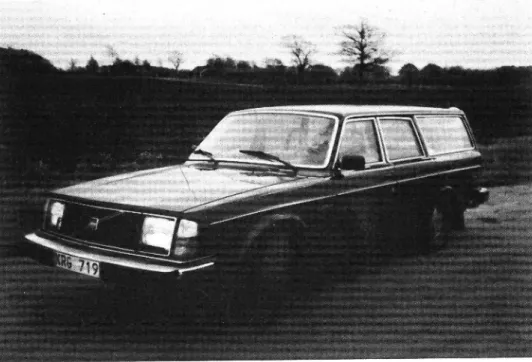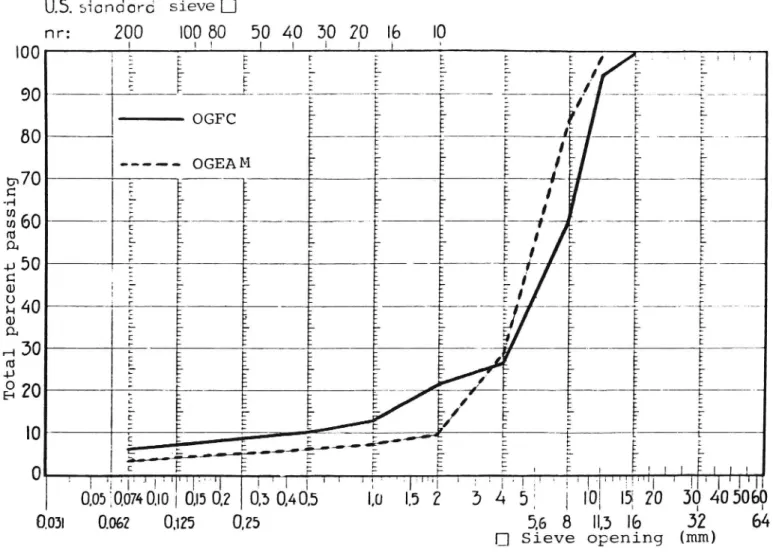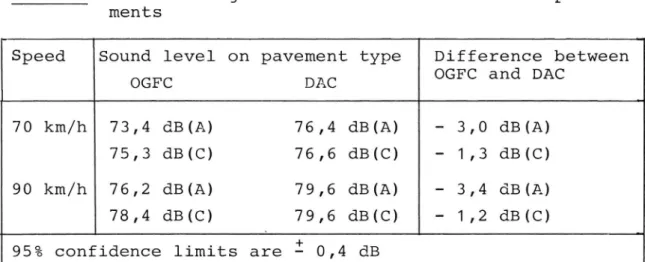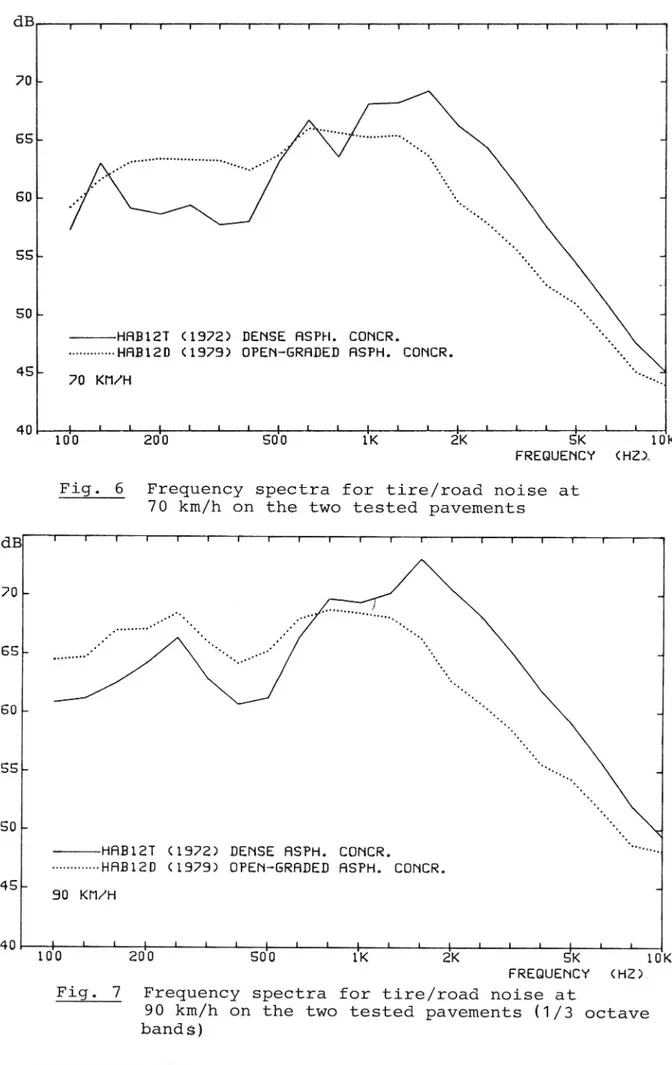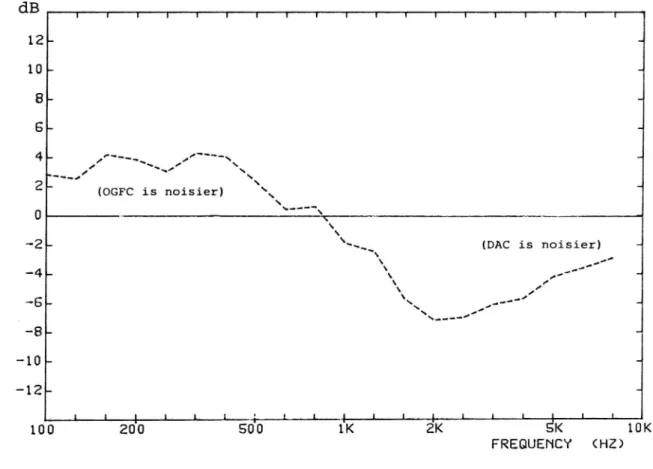fctYeon Bef i swya A
e i n a i v s v Ce A i ~~~ 0
es " dent ens92.4whith hastT> PR Tesis Sone yes ses v - 2A Hip. cates Ja:; Cx Pow Adia NoNE . 0 ca tate f K3"4:»A 0 ay , Abes # - Ae o % s will»... (sols 4 asin Rs KC Soton ¥
tnat cust (yur (CKa do, t f sae rapp lockC4 x " f inanealkmaiteto ateYs % thst ._ a fX 4 : 3 ci o Nane rus ish ast has Na
.lr 221A - 1981
Statens v g- och trafikinstitut (VTI) - 581 01 linkiiping
BSN 0347-6030 National Road & Traffic Research Institute - 8-581 01 Linképing - Sweden
Tire/road noise on an open-graded
,
friction course
CONTENTS Page SUMMARY I SAMMANFATTNING II 1. INTRODUCTION 1 2. THE PAVEMENTS 2
3. VEHICLE AND TIRE TYPE 5
4. AMBIENT CONDITIONS 5
5. TEST METHOD 7
6. PREDICTION OF THE NOISE CHARACTERISTICS 8
7. RESULTS 10
8. DISCUSSION 13
8.1 Difference between the pavements 13
8.2 Assessment of the noise reduction 13
8.3 Suggested improvements 14
9. CONCLUSION 14
Tire/road noise on an Open-graded friction course by Ulf Sandberg
National Swedish Road and Traffic Research Institute
8-581 01 LINKUPING Sweden
SUMMARY
A significant part of traffic noise is caused by the interaction of tires with the road. A relatively effi cient way to abate tire/road noise is to use a road pavement with low-noise characteristics. A pavement group considered beneficial for noise suppression is the so-called open-graded pavements, where the fine-graded portion of the material is very small resulting in a surface with many interconnected Open channels able to efficiently drain water and air in the tire/ road interface through the road surface.
Measurements of tire/road noise from one tire type have been made for speeds of 70 and 90 km/h on two pavements, one of which being an Open-graded friction
course and the other being a conventional, dense-graded
asphalt concrete pavement.
It was found that the Open-graded pavement reduced tire/road noise by 3 dB(A) relative to the dense pave-ment. In relation to the latter pavement, the noise reduction was considerable at high frequencies, whereas there was some impairment at low frequencies. A reduc-tion of 3 dB corresponds to a halving of sound energy. Concerning noise, the tested Open-graded pavement is certainly better than the presently common dense pave ments, but the data are also indicating that it is not quite as efficient for noise suppression as an earlier tested open graded pavement type. Possible ways to optimize noise qualities of Open-graded friction
II
Back/vagbanebuller pa en dranerande vagbelaggning av Ulf Sandberg
Statens vag- och Trafikinstitut
581 01 LINKGPING
SAMMANFATTNING
En icke ovasentlig andel av trafikbullret orsakas av interaktionen mellan bildacken och vagytan, s k dack buller. Ett relativt effektivt satt att bekampa dack-bullret ar att anvanda vagbelaggningar med lagbuller egenskaper. En belaggningsklass som anses lamplig for dylik bullerbekampning ar 5 k dranerande vagbelagg ningar, dar den finare delen av stenmaterialet anvands mycket sparsamt, vilket ger upphov till en "oppen" yta med rikligt med inbordes forbundna kanaler som formar dranera bade vatten och luft fran kontaktytan dack/vag genom belaggningsytan.
Matningar av dackbuller fran en personbilsdacktyp har utforts for hastigheterna 7O och 90 km/h pa tva belagg ningstyper, av vilka den ena utgjordes av en dranerande typ och den andra var en konventionell, tat asfaltbe-tongbelaggning.
Det befanns att den dranerande belaggningstypen redu cerade dackbullret med drygt 3 dB(A) relativt den tata asfaltbetongen. I jamforelse med den sistnamnda be laggningen var bullerreduktionen avsevard i det hogre frekvensomradet, medan en viss okning av bullernivan noterades vid laga frekvenser. En reduktion av bullret med 3 dB motsvarar en halvering av ljudenergin.
I bulleravseende ar séledes den dranerande belaggning en battre an de nu vanliga asfaltbetongbelaggningarna, men data tyder samtidigt pa att den inte ar fullt upp
sa effektiv for dackbullerreduktion som en tidigare
III
provad beléggningstyp. Méjligheterna att férbéttra drénerande beléggningstyper vad géller bulleregenska-per diskuteras.
INTRODUCTION
The importance of tire/road noise as a significant part of total vehicle noise has received growing attention.
It has been recognized as a major component of pass enger car noise at moderate and high speeds, and as a significant component of truck noise at high speeds. The continuing develOpment of more silent vehicle
power units, as is required to satisfy the demands for stricter noise emission standards in the present de-cade from organizations such as OECD, will even more emphasize tire/road noise.
To meet the requirements of traffic safety at high speeds many countries have introduced more deeply textured anti-skid road surfaces on their roads. At the same thne,economic reasons have favoured the use of surface dressings which generally are rough-textured surfaces. Some of these pavements appeared to be
noisier and drew public awareness on tire/road inter-action noise. As a matter of fact, the surface charac-teristics of roads are now known as the main factors influencing car tire/road noise. It has appeared in many investigations that differences in noise emission are greater among pavements than among passenger car
tires.
Initially it was thought that there is a conflict between requirements of high traffic safety and low noise. It has been demonstrated many times now that this was not true; there are many road pavements that combine high skid resistance with low noise emission. Earlier measurements by the Swedish Road and Traffic Research Institute (VTI) have shown that there exists at least one type of pavement on which tire/road noise is significantly lower than on the conventional dense
asphalt concrete pavements so often used in Sweden (ref 1, 2, 3). The "low-noise" pavement is an open-graded emulsified asphalt mix, in the following re-ferred to as OGEAM, of type AEB120 (Swedish designa tion).
The measurements reported herein are concerning another Open-graded pavement with different design. As a re-ference, similar measurements on a conventional dense asphalt concrete pavement are reported.
The objective was to find out if also this type of open-graded surface exhibited a noise reduction potential.
THE PAVEMENTS
Both the tested pavements are situated on road 23 south of Hoor in the southern part of Sweden, 6 km apart from each other. They are:
1. Open graded friction course (OGFC). Swedish
desig-nation: HAB12D. Maximum chipping size: 12 mm. One year old at time of measurement (Nov 1980). See further ref 8.
2. Dense asphaltic concrete (in the following referred to as DAC). Swedish designation: HAB12T. Maximum chipping size: 12 mm. 8 years old, but visually
in fine condition.
The traffic intensity is about 4000 vehicles/24 h (4700 axle pairs). In fig 2 the measurement sites are
shown.
The only quantitative road characterization that was attempted was the measurement of water outflow time
(drainage) by using a device, VTI type III, described in ref 4. The result was:
Pavement Outflow time, t "Drainage resistance"
lO°log t
OGFC 6,6 3 8,2
DAC 316 5 25,0
This can be a basis for comparison with other pave-ments. See fig 1, which shows the "drainage resistance"
(10-log t) for a wide range of Swedish pavements. It can be seen that the DAC pavement has a relatively poor drainage, which is due to a quite smooth surface.
PRUENENT TYPE ( DA C I ( OG FC + - EHL EJ HEDGE! b YYYY I I l III I L I I LII I 0246810121411820222426 DRRINRGE RESISTRNCE (= IOXLOG OUTFLOU TIME ) +CENENT CONCRETE
BRSPHRLT CONCRETE (DENSE) ARUBBER BITUNEN
XDPEN-GRRDED YSURFRCE DRESSING
Fig. 1 A comparison of the "drainage resistance" for
some Swedish pavements tested for noise emission
Fig. 2a The measurement site for the dense asphalt
pavement. The vehicle was coasting in the right lane, the micrcphone was placed where the parked car stands (the car was not there during the measurement).
2b The measurement site for the open-graded
pavement
VEHICLE AND TIRE TYPE
Fig 3 shows the test vehicle which was a Volvo 245 (1981). The tires were:
Goodyear Grand Prix S, 1858R14. Inflation 190 kPa. State of wear: No visually noticeable wear (used for 4 400 km).
A footprint of the tire type, as well as a picture, is
shown in fig 4.
Unfortunately, the tire type is not the same as those used in the work reported in ref 1, 2, 3 in which the OGEAM pavement was measured. On the other hand, it has been shown that modern steel radial tires differ very little in noise emission (ref 2, 3, 6) and there is no reason to expect that any major differences in the comparison between the pavements would have resulted if other similar tires had been used.
AMBIENT CONDITIONS
Air temperatures were O 3OC. The roads were dry. The winds were:
DAC pavement: 2 m/s downwind rel. to vehicle travel
direction
3,2 m/s downwind from microphone to vehicle
OGFC pavement: 1,3 m/s upwind rel. to vehicle travel direction
2,1 m/s upwind from micrOphone to vehicle
The winds were sufficiently low to give a non-signifi cant micrOphone wind noise and are not supposed to influence sound propagation at this short measuring
distance. If, however, wind had.any influence it will misfavour the OGFC, because the air speed relative to the vehicle is higher and the noise has downwind "push" from the vehicle to the microphone for the OGFC, while the conditions were reversed for the DAC.
Fig. 3 The test vehicle: Volvo 245 (1981)
\
\
w.
»
4%..
.
it
$3
M.
»
1!
9
Fig. 4 A picture of the tire and its footprint
TEST METHOD
Tire/road noise was measured using a fixed microphone 1,2 m above road level at 7,5 m from centre line of vehicle path. The test car coasted through the test
section with the engine switched off. The measurement sites were chosen to eliminate serious deviations from acoustic free-field conditions. During a coast-by the noise was recorded for later frequency and level ana lysis. The presented frequency spectra and overall levels were taken at the time of maximum noise level during the coast-by. The time constant was 0,25 s. The
vehicle speeds were 70 and 90 km/h as indicated on the
car speedometer;:mo Speed calibration was made. The spectra and overall values in the report are averages of the 4-6 different runs that were made at each speed and test site.
Measurement and analysis equipment:
PistOphone (for acoustical calibration) B&K 4220
MicrOphone (foam wind-screen was used) B&K 4165
Precision sound level meter B&K 2209
Tape recorder Nagra IV SJ
Frequency spectrum analyzer (1/3 octave) B&K 2131
Computer Databoard
PREDICTION OF THE NOISE CHARACTERISTICS
It might be interesting to compare the OGFC and OGEAM pavements, because the latter was found to be very
efficient for noise suppression (5-6 dB(A) lower
noise emission than on conventional asphalt concrete pavements):
OGFC OGEAM
Grading curve see fig 5 see fig 5
Thickness 29 mm 46 mm
Voids content 21 % 30 %
Binder portion (by weight of mix) 5,2 % 4,1 %
* *
Binder penetration, 250C
70-100
163
Measured drainage resistance 8,2 7,8
*
In tenths of mm
Visually it was observed that the OGFC surface appeared somewhat less open-textured than the OGEAM. This is confirmed by the grading curves, the bigger voids con tent and the smaller drainage resistance measured for the OGEAM. According to the grading curve, the main
part of the chippings are somewhat smaller in the OGEAM, which should give a more even surface.
The thickness of the OGEAM is bigger than that of the OGFC, which means that the conditions for possible sound
*
absorption are best in the OGEAM. Finally, the binder
appears to be somewhat softer in the OGEAM.
According to the findings in ref 2, 3 and 4 one can
predict that this will misfavour the OGFC when comparing its noise suppression potential to that of the OGEAM.
*
Up to a certain limit, sound absorption generally increases with absorptive material thickness.
The OGFC should have less sound absorption, give some-what more vibration input to the tire in the low-fre-quency range (< 1000 Hz) and give somewhat more noise at the higher frequencies due to a slightly poorer drainage.
U.S. sicndoro sieve B
NF:
IE)
I
1 'C D200
|00 00
510 4'0 3'0 2 0
IOO0 O O! O \J O 6 O U 1 C) .b O U Q
N C T o t a l p e r c e n t p a s s i n g
5
0.03: ~ E ;: t : E z t h 5 t t t _ p f p 5 p . : E > L P" r- y- b r u u h I- t - t h r > " P P ' c p0. _'- ,b ,o _r I. 1.-, _ '-... ._._ __. - ._.__ l. ___~ _- .._.-- _. ._ _ .. _ . ~-~- L- » . P .-._ r . p l L . - - - OGFC 7 7*- tv- V : , L s : E t t J»- >-__ _ __ 0..- ._..__4 , C > r- b- E h s. : _ _ . t t , .. p >- u b > r # EA l r 7 r 7 c t E --- : I : t C >-C P- V- b b . u-C :2 C 1'.. Cu. t p. t ': b t .- p L:- L : E L C. L- . »- t C " " I I C > - r- : t " - " f ' _ _ -- t 0 ;- » --*- -. -~ C t p . : >- : u : L b _ .-b D C. C C. .. - > L - h ,. F. p > E - u L. r- b F : : L r- l ». r. r- _ _b a? , % L i >- y- ,-b >- y-: E : ; :b :F- E I :F E E .. p I r P L * : : - p 0 b ' I: h. t >- I- r » L- P ,_ _, ._ p. s . y r A; n _.E ____ __ - - r- r-: : : : t _ - . » L- b ): '- > >- > p C - p- r- p. r- h p L F b ' _ F. *- : - L. r r- r v- } h h >- '-C > p r : t: t, C h t r- : : : I #- I-o b- b L .. )- u h : : > .. c : : C _ P_ I E P " " " " *' C C ». r '- F _ : E r- )- r-- . .. .. p b > ~ ~ ~ r ~' 41 f \ _ > u. p- p . h- C i- : P p u t >-r b-- r- t _ P h L L E- _ t. E r-t : .. _ _- -.. _.- , ~ I: t: I E P E P l v.C L- v7;)- 5'r-'- - . i_V '-E 1:r- 1.t . LL-I W #- ~ >-L: c.1: '_ E - 1 C : rt 5 r- f '- ' ! l l I I v r ' . HI I li :,l'¥l ll.--I (I 10' '.[i-ai 1 .! '1I.IT I! I
I .,E . 1 i I 7
53
10g :5: 20 30 40500
G w U _ _ i 7 I 0.3 0,4 0,5 I0 025z w
.
30.074 0.10 I 0.0 0.2
0.125 3 0050.062
32
64
(mm)5.6 8
H3) l0
; | 4 []Sieve OpeningFig. 5 Grading curves (samples taken from the road)
for the two open-textured pavements compared
10
RESULTS
The frequency spectra representing tire/road noise on the pavements are compared in fig 6 (7O km/h)and.fig 7
(90 km/h). Fig 8 shows the difference between the
pavements. When the curve is above the 0 dB level, the OGFC is noisier; and vice versa. It should be noted that the frequency region of greatest interest is 800-3000 Hz, where the tire/road sound pressure levels (SPL) are highest, and where the human auditory response is strongest. In this range the OGFC is less noisy than
the DAC.
This is resulting in an overall advantage for the OGFC relative to the DAC, which can be seen in table 1 where the overall levels are given. Traffic noise is almost always assessed using the A weighted scale, but the C-weighted levels are included here because they are considered more fair to describe the noise when it has been transmitted through a building facade with closed
windows and ventilators (see ref 7).
It should be noted that the C-weighting used here in-cludes a highpass filter withcut-offat 100 Hz, with the purpose to eliminate wind noise, etc, below 100 Hz.
Table l A-EnMiC-weighted sound levels on the two pave
ments
Speed Sound level onpavement type Difference between
OGFC DAC OGFC and DAC
70 km/h 73,4 dB(A) 76,4 dB(A) - 3,0 dB(A)
75,3 dB(C) 76,6 dB(C) - 1,3 dB(C)
90 km/h 76,2 dB(A) 79,6 dB(A) - 3,4 dB(A)
78,4 dB(C) 79,6 dB(C) - 1,2 dB(C)
95% confidence limits are i 0,4 dB
11 dB r I I I I I I I I I r r I F I I I F r F
70L
~
65L
4
60L 4 SSB 4 SOL J HRB12T (1972) DENSE RSPH. CONCR.L --- nHHBIZD (1979) OPEN GRHDED HSPH. CONCR.
45
7o KN/H
40 'L LL 'L L L L L l .L L L L L L L
100 200 500 1K 2K SK 10K
FREQUENCY (HZA
Fig. 6 Frequency spectra for tire/road noise at
70 km/h on the two tested pavements
dB I I I I I I I I I r F I r r Fir I r
yet
65 60s SS~ SO~HRBIZT (1972) DENSE HSPH. CONCR. """" ~
--- ~HHBIZD (1979) OPEN~GRRDED RSPH. CONCR.
45 '
so Km/H
40 L L L 'L L L L L IL L L IL L L L L L L L [L
100
200
500
1K
2K
sK
10K
FREQUENCY (HZ)
Fig. 7 Frequency spectra for tire/road noise at
90 km/h on the two tested pavements (1/3 octave bands)
dB 12 10 m a m a ) L k u..-\ I " / [I t -I (OGFC is noisier) (DAC is noisier) I L t L l l_ LrL 1 10 l SK FREQUENCY
0
26
(H2)
Fig. 8 Difference in frequency spectra between the
open-graded and the dense pavement. Average
of 70 and 90 km/h (1/3 octave bandsL
VTI REPORT 221A
13
DISCUSSION
Difference between the pavements
From table 1 it can be seen that the OGFC pavement is about 3 dB(A) less noisy than the DAC pavement. This is entirely due to the low noise for the OGFC in the frequency range above 800 Hz. At frequencies lower than 500 Hz, the OGFC is noisier than the DAC, which cancels some of the high-frequency advantage and shows up in the dB(C) values, where the pavements differ only slightly.
In those traffic situations where tire/road is not the dominant traffic noise source, the total improvement
in traffic noise levels will be less.
Assessment of the noise reduction
Traffic noise is almost always assessed by using dB(A) levels. A 3 dB(A) improvement can be illustrated in the following ways:
0 3 dB(A) noise reduction corresponds to a halved
sound energy emission.
0 9-10 dB(A) change in noise level (up or down) is
usually considered as a doubling or halving of subjective response.
0 To obtain a 3 dB(A) reduction in noise by traffic
restrictions, it is necessary to reduce traffic
intensity by 50 %. An alternative traffic restric-tion would be to reduce average speed from 70 to 52 km/h (for example).
0 To obtain a 3 dB(A) reduction in noise by increasing
protection zones between roads and buildings, it is necessary to double the width of the zones.
14
If a new road pavement can reduce traffic noise by 3 dB(A) it is thus possible either to allow twice as much traffic, or to reduce noise protection areas by
50 %, without increasing the noise levels.
Suggested improvements
The OGEAM pavement mentioned earlier was fOund to give better noise reduction (although the basis for
compari-son was notentirely the same). From the theories
pre-sented in ref 3 it follows that improving the noise qualities of pavements in relation to the OGFC tested here, should include some of the following changes:
0 A more open texture shouldbe used. The slope of
the grading curve above 2 4 mm should be as high as possible. This gives better air and water drainage and more sound absorption.
0 The thickness of the wearing course should be
higher because this should increase sound
absorp-tion.
0 Maximum chipping size should be even more limited.
The surface should be rolled to give a prOper ori entation of the chippings, and thus a more even surface. This minimizes the impact of surface mac rotexture elements on the tire tread band and the following deformations in the tire rubber.
CONCLUSIONS
Keeping the limitations in experimental variables in mind (tire type, speed, pavement condition, etc) it can be concluded that the open-graded friction course
tested here, appears to give about 3 dB(A) lower tire/
15
road noise emission than the reference, which was a dense and smooth asphalt concrete pavement.
In certain road and traffic conditions where noise is a problem, this can be beneficial either to the envi-ronment - as a noise reduction - or to economy - as enabling a better utilization of land properties. The tested open-graded friction course is not the optimum low-noise pavement. Earlier tests indicate that better designs, from the noise point of view, can be used. However, a road pavement must always be a compromise between different requirements, and it is possible that the pavement tested here will be bene-ficial in many situations involving noise problems.
16 REFERENCES
/1/
/2/
/3/
/4/
/5/
/6/
/7/
/8/
SANDBERG, U: A road surface for reduction of tire noise emission. VTI preprint No. 45, National Swedish Road and Traffic Research
Institute, Linkoping. (Also proceedings of
INTER-NOISE 79, Warszaw, Poland) (1979).
SANDBERG, U: Characterization of road surfaces with respect to tire noise. Proceedings of the International Tire Noise Conference, Stockholm (1979).
SANDBERG, U; DESCORNET, G: Road surface influence on tire/road noise - Part I
DESCORNET, G; SANDBERG, U: Road surface influence on tire/road noise - Part II
VTI Preprint No. 56, National Swedish Road and Traffic Research Institute, Linkoping, (Also proceedings of INTER-NOISE 80, Miami, USA)
(1980).
SANDBERG, U: A hypothesis concerning the influence of pavement stiffness on external tire/road noise. Internal discussion paper, National Swedish Road and Traffic Research Institute,
Linkoping, (1980),
JOHANSSON, L.G: JOHANSSON, L: Metoder for karak-tarisering av vagbelaggningars yttextur. VTI meddelande No. 62, National Swedish Road and Traffic Research Institute, Linkoping (1977). ULLRICH, S: Tire noise measurements on the high
way and in an internal drum testing apparatus - A background study. Proceedings of the
International Tire Noise Conference, Stockholm (1979).
SANDBERG, U: Tire noise as part of total vehicle noise emission. Proceedings of the Internatio nal Tire Noise Conference, Stockholm (1979). WAGBERG, L.G: Dranerande asfaltbetong. Meddelande
232, National Swedish Road and Traffic Research Institute, Linkoping (1981).


